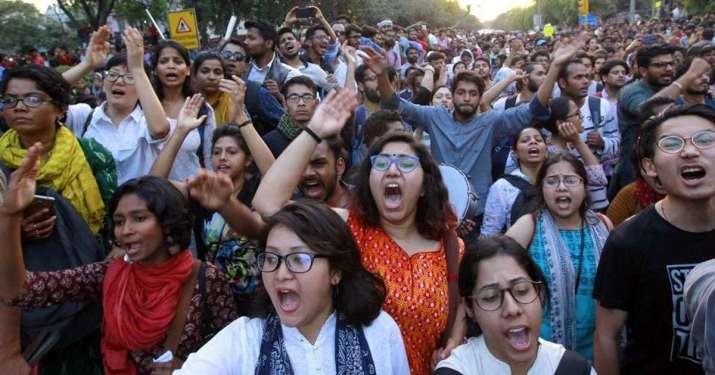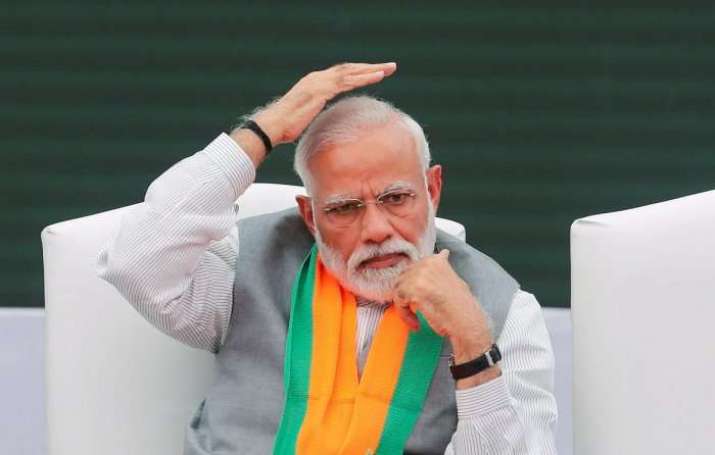FEATURES|THEMES|Social Engagement
Revolution and Counterrevolution in Contemporary India
 From scroll.in
From scroll.inMayura Choudhari is a freelance journalist. She is a visiting faculty member at the Bachelor of Mass Media Department at Siddharth College, Mumbai.
Many believe that religion is a constant presence in human society. When he converted to Buddhism with more than 600,000 of his fellow Dalits, Dr. B. R. Ambedkar said that humanity needs Dhamma, but also outlined the major difference between Dharma and Dhamma (Buddha and His Dhamma 1957, Book 4, Part 1, Chapter 2). Whereas Dharma denotes religion, or a set of beliefs that need not to be questioned but followed, Dhamma refers to the Buddhist philosophy that gives us a set of ethics and morals to be applied in daily life. This application is intended for the betterment of all and the maximizing of collective wellbeing (based on the concept of Bahujan Hitay Bahujan Sukhay—for the happiness of the many, for the welfare of the many).
For millennia, we have been conditioned in such a way that we need some supernatural power to rely on for our own good. Religion imparts hope, direction, and meaning. Yet while human beings created religion, everyone believes that religion created humanity. Be it Christianity or Hinduism or Islam, everyone has their own theory of human development. When we talk about religion, we set logic aside; popular expressions of religions do not generally permit us to question its laws and theories. It is believed that God, gods, or other divine powers, through religion, have been guarding human beings. The reality on the ground contradicts this assumption: it is human beings who have been guarding their religions.
We see this most clearly in contemporary India, where the majoritarian religion of Hinduism is said to always be in danger. Therefore, the first priority of believers has become one of protecting the religion; with violence a justifiable part of the ideology.
India and religious politics
India has been a democratic republic for more than 70 years, a diverse country rich in cultures, languages, and beliefs. Its values of fraternity and secularism are enshrined in its Constitution. Tragically, the majority religion of Hinduism has often contradicted this ideal of “Unity in Diversity,” despite acknowledging differences. It has done so by discriminating and stratifying differences within the religion itself. This deeply rooted cultural inclination is called the Varna System, which has four major Varnas and thousands of castes within. The architects of this divide-and-conquer game benefit at the expense of millions of people, who are taken advantage of and misled.
The Buddha was the first person to challenge this Vedic Dharma, which was and remains based on social discrimination and hierarchy. Thus Buddha denied “Dharma” and established “Dhamma,” the Middle Way, as the way for equity and equality. Dr. B. R. Ambedkar wrote: “India’s history is nothing but mortal conflict between Buddhism and Brahmanism.” (Revolution and Counter-revolution in Ancient India, Part 2, Chapter 7) Since the era of Yuddha (as mentioned in the Rigveda and Vishnupuran), there was always a conflict raging between the indigenous kings of the land and the so-called “Arya” Brahmins that imported their Vedic Dharma into the subcontinent.
Despite being a minority, the Brahmins have successfully bamboozled the majority population of indigenous Indians to see Hinduism as a majoritarian religion under threat. This Vedic bias has been guiding Indian politics for centuries. Today Hinduism has reached the apex of its power. The Brahmin-affiliated classes have used religion as the most useful tool to push the notion of Vedic superiority and its “manifest destiny” over India’s large population.
A non-Indian might see Indian history as a recurring conflict between Hindus and Muslims, Mughals versus Marathas, or partitioned India against Pakistan or Bangladesh. The divide-and-rule policy is blamed on the British, who did use it among Indians, but it originated among the Brahmins, who have used it against indigenous Indians for centuries. Even today we see Hindus and Muslims being divided up for cynical political ends. Hindus are not monolithic, but a collection of many castes segregated by heirarchy, while Muslims in India are converts from lower Hindu castes, similar to the Buddhists that converted after 1956 under the leadership of Dr. Ambedkar.
Although our Constitution frames freedom of religion as a fundamental right and an individual’s choice, actual moves to conversion mostly occur in the so-called lower castes of the caste system, many of whom were treated as untouchables. Thus, during the Mughal period these untouchables chose Islam, during the British Raj they chose Christianity, and in modern India they come to Buddhism in large numbers.
A very recent example of such conversions is from Chennai, where Dalit Cameras (a popular YouTube channel) founder Ravinchandran (now Raees Mohammed), along with many others from his community, converted to Islam in January 2020. All of this just to renounce Hinduism, which never treated them as human beings, or human enough. According to the Vedas, all the lower castes are supposed to live life serving the Brahmins.
 From deccanherald.com
From deccanherald.comThe RSS and anti-NRC/CAA protests
The paramilitary organization of the Rashtriya Swayamsevak Sangh (RSS) is a very powerful organization. Its agenda is open and brazen: to keep Brahmins at the top to rule over all other sectarian factions in India. Like its intellectual predecessors, it has been successfully doing so down the ages. They appeal to religion as its most powerful tool to manage the population’s normative beliefs. Among the 330-million-strong pantheon of Hindu gods, their idol is Parshuram, who defeated the warrior class of Kshatriyas and structured society for Brahmin interests (to this day, the warrior class officially remains below Brahmins in the Varna system). This agenda continues and whoever tries to rise up has faced and will face consequences, including violence. Even Mohandas Gandhi, who many historians agree was at heart a staunch Hindutvavadi, was killed by Nathuram Godse, an RSS member.
The recent National Registry of Citizens (NRC) and Citizenship Amendment Act (CAA) laws are nothing but new strategies of the RSS, pushed by its political wing of the BJP, India’s ruling party, to reinforce a Brahminical vision of anti-secularist, Hindutva proto-fascism. We see Muslims suffering as a result, but there is much more happening. The main objective of this two-pronged CAA-NRC attack is to purge indigenous Indian people and the voices that have been courageous enough to challenge Brahmin authority.
Today, India’s indigenous population is divided into Ambedkarites, atheists, Buddhists, Christians, Communists, Dalits, Muslims, and Tribals. A coalition of these diverse groups is opposing these laws. For more than three months, people from these backgrounds have protested against these bills in all parts of the country. Intellectuals, academics, filmmakers, authors, and students from renowned universities, such as Jawaharlal Nehru University, Jamia Milia Islamia, and The University of Hyderabad, played an active role in the anti-CAA/NRC protests. For the very first time, Muslim women took to the streets demanding their rights.
No political party or any specific organization is leading this movement against the BJP, but these people, aware of their rights and also mindful of the strategy of their increasingly fascist government and their objectives, which they have seen achieved in the state of Assam and the Jammu-Kashmir bifurcation. Detention centers have become a most horrifying reality. The protestors invoke in their marches the secularist Indian constitution, much like Dr. Ambedkar, who challenged the authority of religious Dharma. Protestors are holding up Dr. Ambedkar’s image and copies of the Indian Constitution to show their dissent with the Hindutva agenda of the BJP.
The RSS, through the BJP, knows that silencing the educated population and intellectual, artistic, and literary movements has become a very difficult task. The BJP and affiliated groups have simply resorted to mob violence, killing and burning in the streets. The overwhelmingly pro-BJP media might call incidents in the east of New Delhi “riots,” but video evidence from mobile phones and testimonies from Muslim victims and Hindu attackers confirm that the Modi-Shah government’s use of unemployed youth, many of them angry and without real prospects (something that the government does not seem to acknowledge), by provoking them to protect Hinduism and create riot-like situations.
Many Muslim homes have been burned down, women harassed, men killed, and students beaten. The tragedy is that those committing the violence are themselves indigenous people excluded from knowledge and development for thousands of years. Without education, their ways of proving their citizenship, and moreover their sense of nationality and patriotism, is by proclaiming exclusionary, inflammatory slogans such as “Jai Shri Ram,” and acting out their loyalty and love for India through violence. Their alternative is being subject to violence or even murder themselves.
I believe that a revolution is emerging in the footsteps of the Tathagata Buddha, Saint Kabir, Saint Raidas, Jotiba and Savitribai Phule, Bhagat Singh, Dr. Ambedkar, Periyar Ramaswami, and many such reformist icons. Northeast Delhi and many other areas are burning, but other locales are rising up against Brahmanism and preparing for a much bigger revolution against systems of social oppression. The true revolution will come when the Hindu majority understand the importance of “religion for humanity” rather than “humanity for religion.” The former is authentic, compassionate, and inclusive. The latter leads to a path of zealotry and darkness, as we see what’s unfolding across India now.
Related features from Buddhistdoor Global
Buddhistdoor View: Political Belonging Has Become a Religious Matter in India
Related news from Buddhistdoor Global
Buddhists in Bodh Gaya Fear for the Future After India Enacts New Citizenship Law
Ladakh Becomes India’s First Buddhist-majority Union Territory Following Kashmir Bifurcation
Buddhistdoor Global Special Issue 2020














